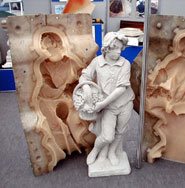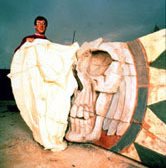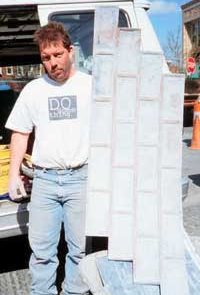- Staining Concrete
- Stamped Concrete
- Concrete Overlays
- Concrete Resurfacing
- Concrete Polishing
- Concrete Dyes
- Colored Concrete
- Indoor Concrete
- Concrete Floors
- Concrete Countertops
- Garage Floor Coatings
- Furniture, Sinks, Fire Bowls
- Basement Floors
- Outdoor Concrete
- Concrete Patios
- Concrete Driveways
- Concrete Pool Decks
- Outdoor Kitchens & Counters
- Outdoor Fireplace
- Concrete Walkways
- Concrete Pavers
- Concrete Walls
- Repair & Maintenance
- Foundation Repair
- Concrete Crack Repair
- Concrete Sealers
- Building with Concrete
- Concrete Homes
- Concrete Basements
- Decorative Concrete
Smooth-On's Liquid Rubbers and Plastics
A Smooth Operation for Artists and IndustryGet ready for a romantic evening —take a luxurious bath, light candles on the patio, rearrange the art to display a wonderful sculpture, and make sure you have a movie on hand if all plans fail. There is a surprising essential ingredient used to create the ambience. It is mold making! Smooth-On ®, Easton, PA sells liquid rubber and plastic casting materials and has the expertise to make all kinds of molds from soaps, candles, and sculpture, to concrete and even special glass for movies called smash plastic! With Smooth-On, the door opens for concrete contractors to create imprinting tools, textures for wall pours or molds for unique counter-tops.
Why Make a Mold?
In the last 3-5 years, Smooth-On experienced a 50-60% increase in business from concrete contractors. In ever increasing numbers, contractors want to make molds in spite of the fact that buying pre-manufactured stamps to imprint concrete and form liners to create decorative walls is so much easier. There are many good reasons for making your own mold: an architect with a special project designs a one-of-a-kind imprint; a customer has a treasured item to duplicate; a client comes with a uniquely shaped counter-top —and you charge more, because you are an artisan who is also a decorative concrete contractor. New textures and patterns that do not currently exist are within your creative reach, setting you apart from the competition.
Use is another consideration for mold making. It is not cost-effective to buy a mass-produced mold to use only once or twice. Instead, purchase less expensive material and make it yourself. Smooth-On manufactures products in varying strengths to meet the requirements for varying uses–20 different pourable and 6 brush-on varieties of liquid mold materials.
The Learning Curve
Making a mold is new technology for many. Mark Vorhis, Concrete Specialist with Smooth-On says "Mold-making seems a mystery like any other craft until you do it enough and then it becomes second nature. Just as an artist doesn't learn to paint overnight, mold-making has a learning curve too." The discussion with Vorhis repeatedly returns to Smooth-On's view that their job is to bring your mold-making abilities up to speed as soon as possible. As Vorhis says, "Nothing is worse for business than having piles of material sitting in the warehouse never tried." So, customer service with tech field support at the other end of the phone, or by e-mail, is a major focus at Smooth-On. Phone calls can average 30 minutes, He adds, "We take the time to give support so that our customers are successful. We also offer monthly seminars focusing on mold-making technology."
Assuming there is a stone in some part of the country that a person wants to replicate, the goal is to make a negative form of the positive object. Actually, the very first step is to get permission if the stone is on someone's property! Then, decide if your mold making is for few or multiple uses and consider the final size.
Steps:
- Seal the stone with a product called "Super-Seal".
- After sealing the stone, apply a release agent. Smooth-On manufactures Universal Mold Release
- Construct the frame for the mold—a mold box.
- Variation begins:
* A large regularly used mold requires a brushable urethane rubber and creates a "Skin-type" mold about 1/4 inch thick.
* Doing a stone veneer, flat on one side, requires about an inch of pourable material.
* A smaller, more 2-dimensional mold, for walls, uses a pourable urethane rubber and creates a block-mold. - Wear protective clothing, be in a well-ventilated space, and pay attention to the temperature of the environment.
- Make your object secure by using silicone caulk, a glue gun, or Super Instant Epoxy™.
- Be sure to seal the seams of the mold box so that liquid rubber does not leak out the sides or bottom.
- Mix the mold rubber thoroughly. Improper curing is often due to impropermixing. As the directions on the website say...When you think the rubber is mixed enough mix it again just to make sure!
- Pour the rubber over the original object. To prevent entrapping air, find the lowest point in the mold box and pour the rubber there —in a single spot and at a slow, constant rate. Let the rubber rise up and over the positive object. This displaces air from the lowest point and helps minimize air entrapment. Pouring rubber directly onto the model tends to trap air.
- To cure, the rubber needs to turn from a liquid to a flexible solid. Cure overnight at a room temperature of 77°F /25°C.
- In a successful mold, the rubber flexes easily and the original model releases from the cured rubber. The mold should preserve every bit of detail down to the fingerprints on the original.
Two brothers from Holland worked day jobs, but, at night, went next door to the Singer Sewing Machine shop. They gathered metal filings dropped where a lathe turned out sewing machine components. The droppings, mixed with water and cement, became a repair material. In 1895, Smooth-On, with its product Iron Cement, repaired leaks and cracks in boilers, pipes, and furnaces. The process was used into the 1950's, until plastics entered the arena. Then Smooth-On turned its attention to the adhesive capabilities of epoxy resins and polysulfide polymers, which cure to form flexible rubber. Liquid rubber, and plastics based on polyurethanes, entered the marketplace in the1970"s with mold-making application to industry and art.
Where to learn more
Check out the Concrete Molds section
Visit the website www.smooth-on.com. Click on some of their annotated links:
- Architectural Restoration
- Candlemaking
- Concrete Casting
- Prototyping
- Sculpture
- Taxidermy
- Special Effects
- Liquid rubber
- Liquid Plastic
- Foams
- duoMatrix
- Adhesives
Find the distributors near you, order on-line and if you do not want to make molds yourself, there are contractors listed who will make molds for you. Find additional directions to amplify mold making and highlights of the latest technological developments in the field.
So, put some serious romance in your life and give Smooth-On a call. You might fall in love with mold making!
Mark Vorhis at 1-800-762-0744 or by email, mvorhis@smooth-on.com
Jeanne Fields is the owner of Fields Marketing, which provides marketing services for contractors and manufacturers in the decorative concrete industry.








